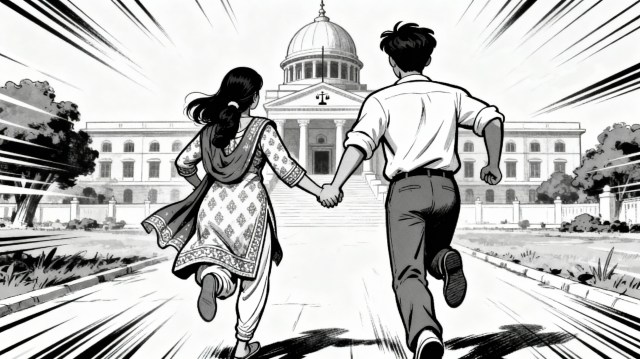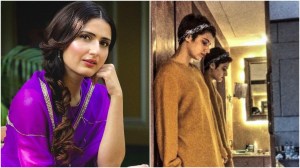In a recent decision, the Punjab and Haryana High Court granted protection to an unmarried couple in a live-in relationship after they claimed they were being threatened by the family members of one of them.
The court ruled that the “state is obligated to protect the life and liberty of such couples even if they are not married but are in a live-in relationship”.

In recent times, several unmarried couples, who are major and in live-in relationships, have knocked on the doors of the courts fearing violence, harassment or coercion from their families. They feel courts are the only recourse to get protection, particularly in cases where they belong to different faiths or have run away from home, fearing violence to life and limb.
The Indian Express speaks to advocate Utkarsh Singh, who specialises in such cases and has successfully secured protection for several such couples from courts, to understand the legal challenges surrounding live-in relationship couples and their safety.
Excerpts follow:
1. As someone who has represented such couples a number of times, what becomes the biggest legal challenge in convincing courts?
Singh: The biggest challenge is when one has to convince the court that these are citizens of India who are exercising their constitutional right. They should not be seen with the view that they are going against society or they are going against family values or ethos. They are individuals with individual rights given by the constitution, and that is what is to be seen, and the ethos of society should not be considered while granting or not granting relief.
2. How often do courts refuse protection in such cases? What are the primary reasons for not granting protection?
Singh: Usually, it is only when one or either of the individual in the couple is married or sometimes it happens when there is an FIR or a complaint lodged against one of the individuals like whether the person has eloped or whether the person has taken out some belongings related to the parents and now the person is using those belongings for the survival during the period of elopement.
Then usually courts are reluctant to grant relief. Sometimes, the area is sensitive, so the bias comes into the picture.
Story continues below this ad
3. What are the different legal provisions under which such runaway couples can seek protection before a court?
Singh: There is a marvellous judgement known as Shakti Vahini v. Union of India. It protects these couples, their rights, well-being and the fundamental issues which may arise, like inaction on the part of police and authorities, and hence they are penalised by this judgement. So, the judgement has certain measures like remedial measures, punitive measures, and supportive measures.
So, one of the punitive measures is that if a couple approaches a police station and there is no action on the part of the police station, then by virtue of this judgement, action can be taken against the police officers or maybe the khap panchayat or the individuals who are against the live-in relationship.
4. Can such a couple move a trial court? Or the right to protection is only granted by a constitutional court?
Singh: This is a very good question about whether they can move the trial court or it has to go to the constitutional court only. Now, whether the live-in couple is intending to marry – that is the question. If they say that they are living together and they are seeking an order of protection against society, and they have an intent to marry, then the high court is the best possible forum to go and seek protection.
But by virtue of this judgement, Shakti Vahini v. Union of India, special cells are to be created in every district to protect the well-being of these couples. So, the forum has now, by the virtue of this judgement, shifted from the high court to the special cell, which has to be headed either by the DCP (deputy commissioner of police) or a senior level officer.
Story continues below this ad
5. Should states in India come out with laws or rules for granting protection to such couples as it is often noticed that moving court seems like their only legal remedy?
Singh: That is only because if you decide to go to court, you have to go to it. Now, you have an option that you can approach the special cell of your district. In Punjab and Haryana, there is a writ petition I guess and in this case, the home secretary, Haryana, has filed an affidavit saying that they are running safe houses in every district.
So, this, in turn, gives you an opportunity, before going to court, you can approach the authorities.
6. Among the cases, what are some of the most interesting ones in terms of legal challenge?
Singh: I was appearing for a transgender couple, and it was probably one of the first cases to be dealt with under the judgement of Shakti Vahini. Shakti Vahini talks about interfaith, inter-caste, and such couples who are persecuted.
So, this couple came from Punjab, and they came to Delhi seeking protection, because Delhi was the first state to implement Shakti Vahini in its letter and spirit.
So, that couple sought protection from the Delhi High Court, and the state’s objection was that LGBTQ+ ( (lesbian, gay, bisexual, transgender, and queer) couples cannot be granted protection under this judgement. But it was Justice Mukta Gupta who said that they would be granted protection, and the couple was transferred to a safe house.
Story continues below this ad
7. Which states or regions have you noticed have the highest number of live-in couples approaching courts for protection?
Singh: It is the NCR (national capital region) because the individuals are more empowered, financially independent from the family and they have an independence to a level where they can take their own calling.
8. What gaps have you noticed when it comes to extending protection by state authorities which compel such couples to move courts?
Singh: It is the fear of facing the brunt as the family members can face pressure from the police and could be separated by use of force, or money. What we see is that the assertion of right in NCR is more owing to the fear of getting carried away compared to places like Patna, Lucknow or any other remote areas.

































